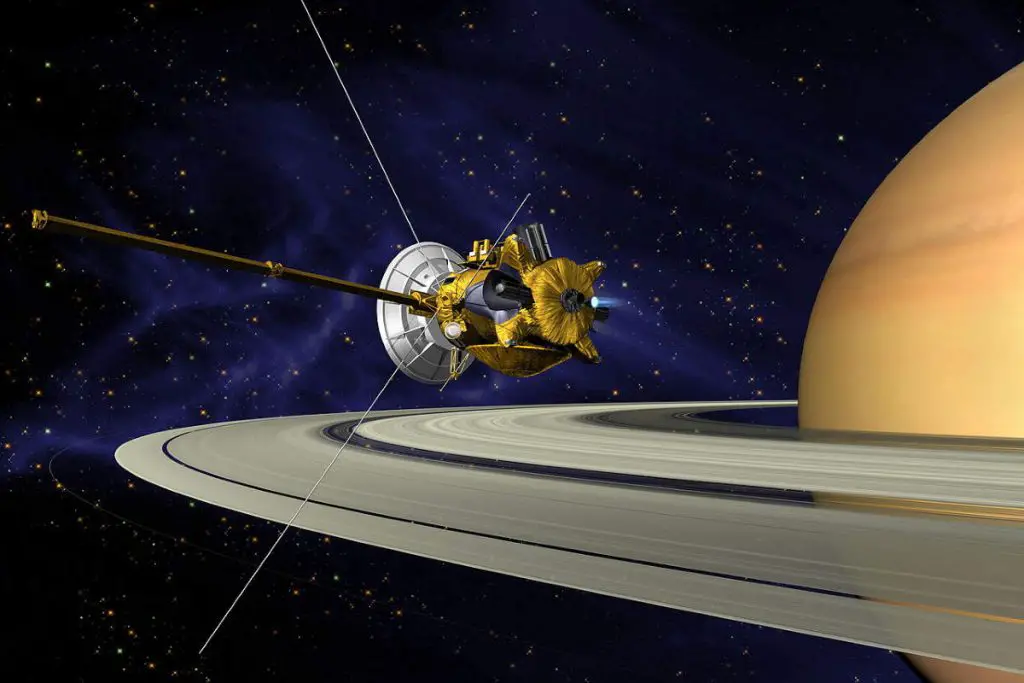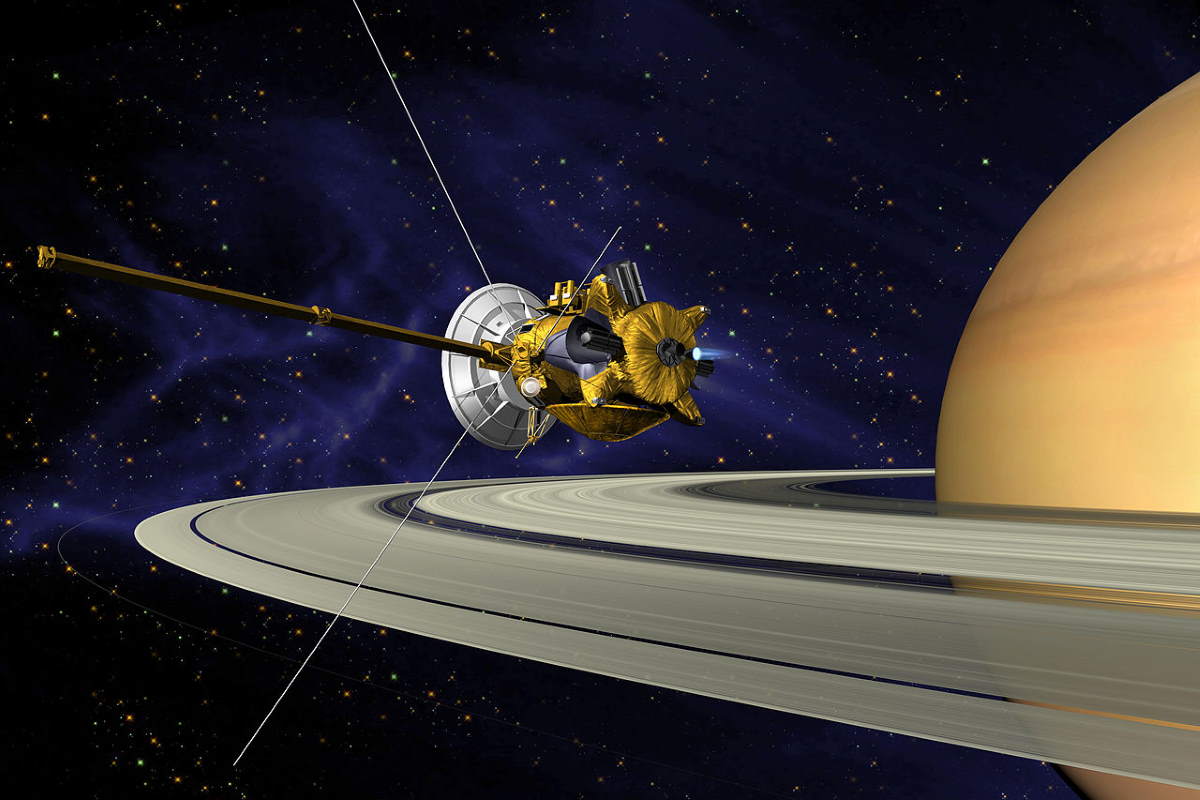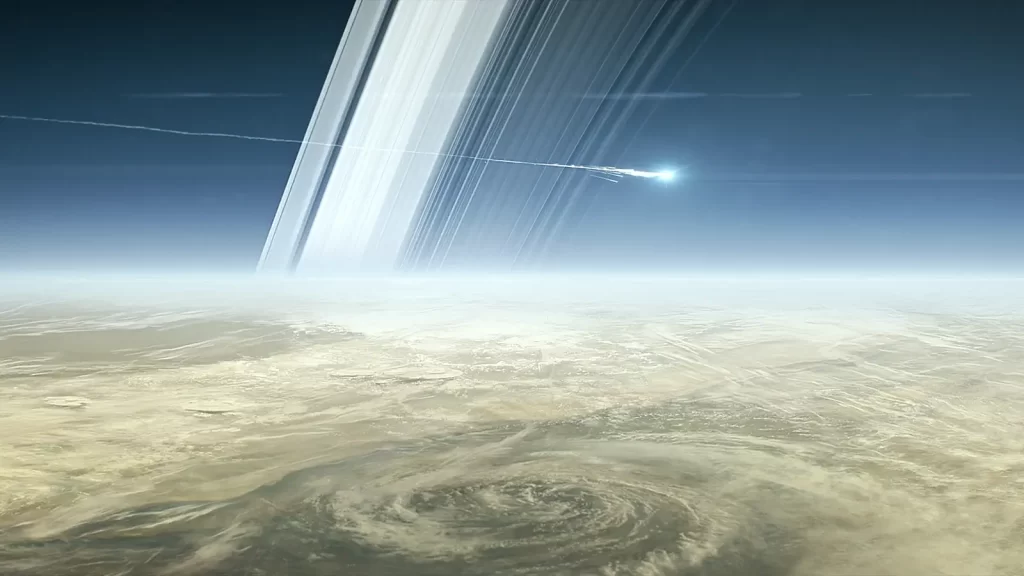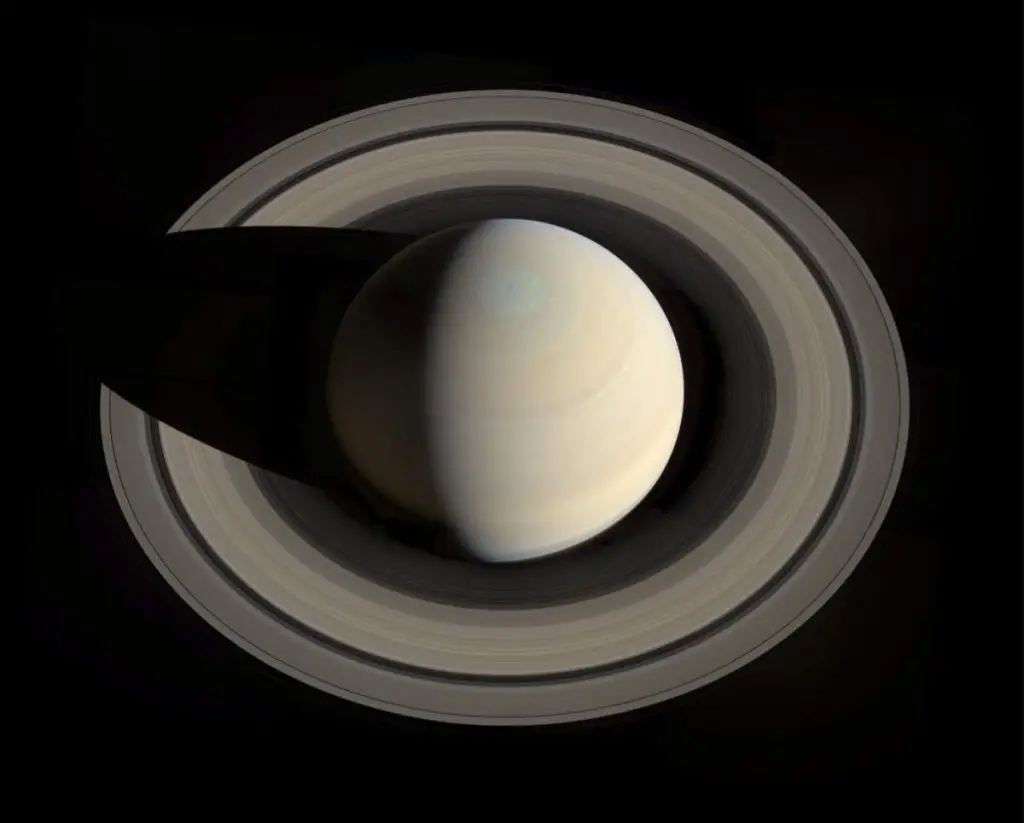NASA’s Cassini space probe entered Saturn’s orbit on July 1, 2004, and became the first spacecraft to orbit the ringed planet.
Today’s (July 1) story of what happened this day in Science, Technology, Astronomy, and Space Exploration history.
Cassini’s Saturn Orbit Insertion
On July 1, 2004, the Cassini-Huygens spacecraft flew through the gap between the F and G rings and achieved orbit, after a seven-year voyage. It was the first spacecraft to ever orbit Saturn.
The Saturn Orbital Insertion (SOI) maneuver performed by Cassini was complex, requiring the craft to orient its High-Gain Antenna away from Earth and along its flight path, to shield its instruments from particles in Saturn’s rings.
Once the craft crossed the ring plane, it had to rotate again to point its engine along its flight path, and then the engine fired to decelerate the craft by 622 meters per second (1391.37 mph or 2239.2 km/h) to allow Saturn to capture it.
The probe was captured by Saturn’s gravity at around 8:54 pm Pacific Daylight Time on June 30, 2004. During the maneuver, Cassini passed within 20,000 km (12,000 mi) of Saturn’s cloud tops.

Definition: Orbit Insertion
Orbit insertion is a special spaceflight operation of adjusting a spacecraft’s momentum, in particular, to allow for entry into a stable orbit around a planet, moon, or other celestial body. This maneuver involves either deceleration from a speed in excess of the respective body’s escape velocity, or acceleration to it from a lower speed.
Timeline of Cassini’s Saturn Orbit Insertion
Ground DateTime (UTC): Activity. Description
- June 23 01:23: Activate SOI critical sequence and begin a quiet period. An 8-day period of minimal spacecraft activity begins. Solid State Recorders (SSRs) are set to SOI (Saturn Orbit Insertion) configuration.
- June 29 20:24: Orbiter transitions to SOI telemetry mode. Dual record of engineering on both Solid State Recorders (SSRs) begins; only real-time engineering at 1896 bps downlinked.
- June 29 21:24: Begin critical commanding for SOI. The critical sequence begins issuing commands for SOI (burn start – 29 hours).
- July 01 00:51: Transition to Low-Gain Antenna 1 (LGA-1) communication. Telemetry is turned off, the carrier only for SOI communication.
- July 01 01:11: Turn to protective attitude for ascending ring-plane crossing. This maneuver protects the spacecraft from dust encountered in-ring plane, turn takes 10 minutes.
- July 01 02:11: Ascending ring-plane crossing. Distance = 158,500 km (98,500 miles); High-Gain Antenna (HGA) is oriented to dust ram direction.
- July 01 02:21: Turn to burn attitude. The turn takes 10 min; 6 min spare time after turn completion before the burn start.
- July 01 02:35: Open latch valves. Valves opened in preparation for the pressurized burn.
- July 01 02:36: Saturn Orbit Insertion burn starts. Main engine maneuver, velocity change = 626 meters per second (1400 mph); 96-minute burn.
- July 01 02:59: Cassini passes behind Saturn’s F ring as seen from Earth. Communication with the spacecraft is still likely.
- July 01 03:06: Cassini passes behind Saturn’s A ring as seen from Earth. Communication with the spacecraft is unlikely for 25 minutes.
- July 01 03:31: Cassini passes behind the Cassini division as seen from Earth. Brief communication with the spacecraft is possible for 6 minutes. The Cassini Division is a region 4,800 km (3,000 miles) in width between Saturn’s A Ring and B Ring. It was discovered in 1675 by Giovanni Cassini at the Paris Observatory using a refracting telescope that had a 2.5-inch objective lens with a 20-foot-long focal length and a 90x magnification.
- July 01 03:37: Cassini passes behind Saturn’s B ring as seen from Earth. Communication with the spacecraft is unlikely for 28 minutes.
- July 01 03:54: Saturn orbit achieved. The spacecraft has slowed enough to be captured by Saturn’s gravity and is no longer in escaping orbit (78 min into burn).
- July 01 04:03: The closest approach to Saturn in the entire mission. Distance = 80,230 km (49,850 miles) from the center of Saturn, 19,980 km (12,400 miles) from the cloud tops.
- July 01 04:05: Cassini passes behind Saturn’s C ring as seen from Earth. Communication with the spacecraft is restored until science turns (the C ring is less opaque to Cassini radio frequencies than the A or B ring).
- July 01 04:12: Saturn Orbit Insertion nominal burn ends.
- July 01 04:15: Reconfigure radio comm, close main engine cover, begin a turn to Earth-point. The main engine cover is closed to protect engine nozzles during descending ring plane crossing; will shift if the burn ends late.
- July 01 04:18: Spacecraft on Earth-point. Will shift if burn ends late.
- July 01 04:21: Nominal end of the critical sequence, the main engine cover is fully closed. Will shift if burn ends late.
- July 01 04:22: Saturn Orbit Insertion max burn end.
- July 01 04:24: Cassini passes behind Saturn’s D ring as seen from Earth. Communication with the spacecraft remains likely (The D ring is less opaque to Cassini radio frequencies than the A or B ring).
- July 01 04:30: Max end of the critical sequence. Background sequence takes over spacecraft control.
- July 01 04:30: Switch to High-Gain Antenna (HGA) communication. Telemetry resumes, 1896 bits per second real-time engineering data transmitted.
- July 01 04:31: Turn off Earth-line for post-burn science observations. Background sequence turns spacecraft to view Saturn’s rings and magnetosphere, communication with the spacecraft is not possible.
- July 01 04:39: INMS cover is jettisoned. Ion & Neutral Mass Spectrometer (INMS) cover is removed for post-SOI observations.
- July 01 04:54: Cassini passes behind Saturn’s C ring as seen from Earth: Cassini should be in science attitudes and will not be communicating with Earth, otherwise communication with the spacecraft is possible.
- July 01 04:57: Cassini passes behind Saturn as seen from Earth. Cassini should be in science attitudes and will not be communicating with Earth, otherwise communication with the spacecraft is not possible.
- July 01 05:32: Turn to protective attitude for descending ring-plane crossing.
- July 01 05:33: Cassini emerges from behind Saturn (and is behind A ring). Cassini should be in science attitudes and will not be communicating with Earth, otherwise communication with the spacecraft not likely.
- July 01 05:44: Cassini emerges from behind A ring as seen from Earth. The space probe should be in science attitudes and will not be communicating with Earth, otherwise communication with the spacecraft is possible.
- July 01 05:58: Descending ring-plane crossing. Distance = 158,500 km (98,500 miles); HGA is oriented to dust ram as directed by background sequence.
- July 01 07:00: The spacecraft returns to Earth-point, SOI data playback begins. Double playback of SOI science & engineering data for 19.5 hours; data played back over Madrid, then Goldstone Deep Space Communications Complex.
- July 01 07:12: Open main engine cover. Main engine cover is opened for upcoming post-SOI maneuver.
- July 01 10:49: Switch to reaction wheel control. The spacecraft has been controlled with thrusters since before SOI; now reaction wheel control is appropriate.
- July 01 12:39: First SOI images returned. Post-SOI images of Saturn and rings are retrieved from recorders.
Sources
- Cassini mission page on the NASA Solar System Exploration website
- Cassini-Huygens on Wikipedia
- Cassini Saturn Orbit Insertion Timeline on the NASA website
- Moon Landings: All-Time List [1966-2025] - February 2, 2025
- What Is Max-Q and Why Is It Important During Rocket Launches? - January 16, 2025
- Top 10 Tallest Rockets Ever Launched [2025 Update] - January 16, 2025


